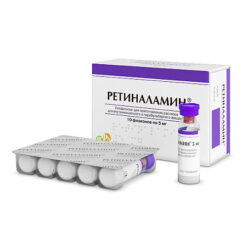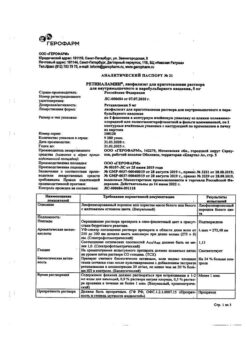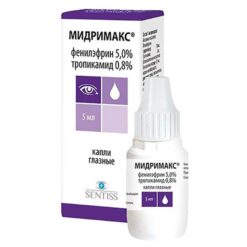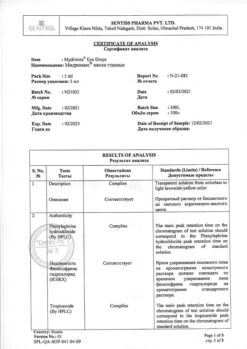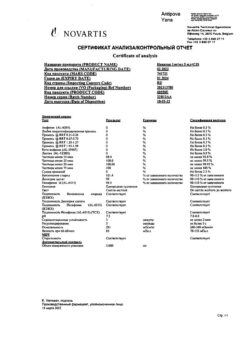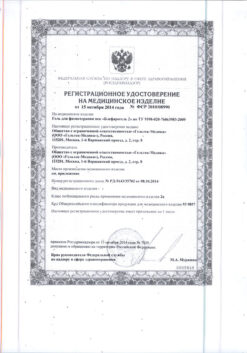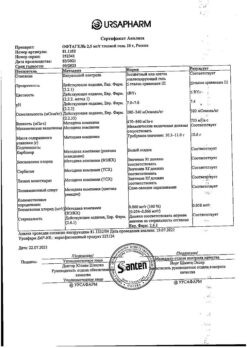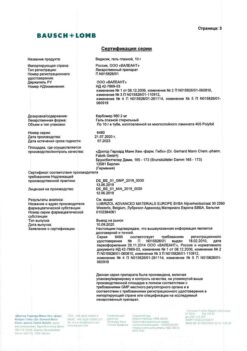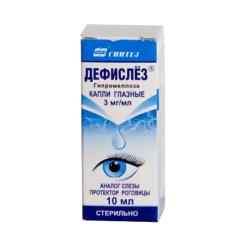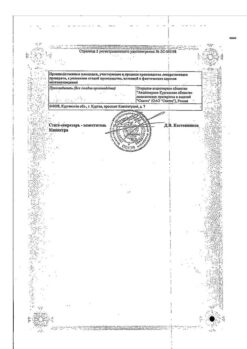No products in the cart.
Oftocipro, eye ointment 0.3% 3 g
€1.00
Out of stock
(E-mail when Stock is available)
Description
Oftocipro is an antimicrobial.
Pharmacodynamics
. Broad spectrum antimicrobial, fluoroquinolone derivative, inhibits bacterial DNA-gyrease (topoisomerases II and IV, responsible for DNA unwinding for further transcription process), disrupts DNA synthesis, bacterial growth and division. It acts bactericidally on Gram-negative organisms during quiescence and division, on Gram-positive microorganisms – only during division.
Ciprofloxacin is sensitive to Gram-negative aerobic bacteria: Enterobacteriaceae (Escherichia coli, Salmonella spp., Shigella spp., Citrobacter spp., Klebsiella spp., Enterobacter spp, Proteus mirabilis, Proteus vulgaris, Serratia marcescens, Hafnia alvei, Edwardsiella tarda, Providencia spp., Morganella morganii, Vibrio spp., Yersinia spp.), other Gram-negative bacteria (Haemophilus spp., Pseudomonas aeruginosa, Moraxella catarrhalis, Aeromonas spp, Pasteurella multocida, Plesiomonas shigelloides, Campylobacter jejuni, Neisseria spp.), some intracellular pathogens (Legionella pneumophila, Brucella spp, Chlamydia trachomatis, Listeria monocytogenes, Mycobacterium tuberculosis, Mycobacterium kansasii, Corynebacterium diphtheriae); Gram-positive aerobic bacteria:Staphylococcus spp. (Staphylococcus aureus, Staphylococcus haemolyticus, Staphylococcus hominis, Staphylococcus saprophyticus), Streptococcus spp. (Streptococcus pyogenes, Streptococcus agalactiae).Most staphylococci resistant to methicillin are also resistant to ciprofloxacin. The sensitivity of Streptococcus pneumoniae, Enterococcus faecalis, Mycobacterium avium(located intracellularly) is moderate (high concentrations are required for their suppression).
Bacteroides fragilis, Pseudomonas cepacia, Pseudomonas maltophilia, Ureaplasma urealyticum, Clostridium difficile, Nocardia asteroides are resistant to the drug. Ineffective against Treponema pallidum. Resistance develops very slowly because, on the one hand, after ciprofloxacin action practically no persistent microorganisms remain, and on the other hand, bacterial cells have no enzymes which inactivate it.
Pharmacokinetics
In local administration, systemic absorption is low.
Indications
Indications
Any of the diseases indicated in the list, in cases where the causative agents are bacteria sensitive to the active substance:
acute and subacute conjunctivitis,
blepharitis,
blepharoconjunctivitis,
keratitis,
keratoconjunctivitis,
bacterial corneal ulcer,
chronic dacryocystitis,
meibomite,
infectious eye lesions after injury or foreign bodies,
Pre- and postoperative prevention of infectious complications in ophthalmic surgery.
Pharmacological effect
Pharmacological effect
Oftocipro is antimicrobial.
Pharmacodynamics
A broad-spectrum antimicrobial agent, a fluoroquinolone derivative, inhibits bacterial DNA gyrase (topoisomerases II and IV, responsible for unwinding DNA to ensure further transcription), disrupts DNA synthesis, growth and division of bacteria. It has a bactericidal effect on gram-negative organisms during the period of rest and division, on gram-positive microorganisms – only during the period of division.
Gram-negative aerobic bacteria are sensitive to ciprofloxacin: enterobacteria (Escherichia coli, Salmonella spp., Shigella spp., Citrobacter spp., Klebsiella spp., Enterobacter spp., Proteus mirabilis, Proteus vulgaris, Serratia marcescens, Hafnia alvei, Edwardsiella tarda, Providencia spp., Morganella morganii, Vibrio spp., Yersinia spp.), other gram-negative bacteria (Haemophilus spp., Pseudomonas aeruginosa, Moraxella catarrhalis, Aeromonas spp., Pasteurella multocida, Plesiomonas shigelloides, Campylobacter jejuni, Neisseria spp.), some intracellular pathogens (Legionella pneumophila, Brucella spp., Chlamydia trachomatis, Listeria monocytogenes, Mycobacterium tuberculosis, Mycobacterium kansasii, Corynebacterium diphtheriae); gram-positive aerobic bacteria: Staphylococcus spp. (Staphylococcus aureus, Staphylococcus haemolyticus, Staphylococcus hominis, Staphylococcus saprophyticus), Streptococcus spp. (Streptococcus pyogenes, Streptococcus agalactiae). Most staphylococci resistant to methicillin are also resistant to ciprofloxacin. The sensitivity of Streptococcus pneumoniae, Enterococcus faecalis, Mycobacterium avium (located intracellularly) is moderate (high concentrations are required to suppress them).
The following are resistant to the drug: Bacteroides fragilis, Pseudomonas cepacia, Pseudomonas maltophilia, Ureaplasma urealyticum, Clostridium difficile, Nocardia asteroides. Ineffective against Treponema pallidum. Resistance develops extremely slowly, since, on the one hand, after the action of ciprofloxacin there are practically no persistent microorganisms left, and on the other hand, bacterial cells do not have enzymes that inactivate it.
Pharmacokinetics
When applied topically, systemic absorption is low.
Special instructions
Special instructions
It is not recommended to wear contact lenses during treatment with the drug.
When using other ophthalmic drugs, the interval between their administration should be at least 5 minutes.
Impact on the ability to drive vehicles and operate machinery.
Immediately after using the eye ointment, blurred visual perception is possible, which can lead to difficulty driving vehicles and working with machinery; It is recommended to start work (driving) 15 minutes after using the drug.
Active ingredient
Active ingredient
Ciprofloxacin
Composition
Composition
Active substance:
ciprofloxacin hydrochloride (in terms of ciprofloxacin) 0.3 g
Excipients:
nipagin (methyl parahydroxybenzoate) – 0.2 g;
medical petroleum jelly – 89.55 g;
anhydrous lanolin – 9.95 g
Pregnancy
Pregnancy
Contraindicated during pregnancy, lactation and children under 2 years of age.
Contraindications
Contraindications
hypersensitivity;
pregnancy;
lactation period;
children’s age (up to 2 years);
viral and fungal eye infections.
With caution: in patients with cerebral atherosclerosis, cerebrovascular accident, convulsive syndrome.
Side Effects
Side Effects
Allergic reactions, itching, burning, mild soreness and hyperemia of the conjunctiva, nausea, rarely – swelling of the eyelids, photophobia, lacrimation, sensation of a foreign body in the eyes, unpleasant taste in the mouth immediately after application, decreased visual acuity, the appearance of a white crystalline precipitate in patients with corneal ulcers, keratitis, keratopathy, corneal infiltration, development superinfections.
Interaction
Interaction
The interaction of Oftocipro ophthalmic ointment with other drugs when used simultaneously has not been described.
There is evidence that the systemic use of some quinolones leads to an increase in the concentration of theophylline in the blood plasma, affects the metabolism of caffeine and enhances the effect of oral anticoagulants (including warfarin and its derivatives).
A transient increase in serum creatinine levels has been reported in patients prescribed cyclosporine with systemic ciprofloxacin.
Overdose
Overdose
If the drug is accidentally taken orally, there are no specific symptoms.
Nausea, vomiting, diarrhea, headache, fainting, and anxiety may occur.
Treatment: standard emergency measures, adequate fluid intake, acidification of urine to prevent crystalluria.
Storage conditions
Storage conditions
At 2–25 °C
Shelf life
Shelf life
2 years
Manufacturer
Manufacturer
Tatchimpharmpreparaty, Russia
Additional information
| Shelf life | 2 years |
|---|---|
| Conditions of storage | At 2-25 °C |
| Manufacturer | Tatkhimpharmpreparaty, Russia |
| Medication form | eye ointment |
| Brand | Tatkhimpharmpreparaty |
Related products
Buy Oftocipro, eye ointment 0.3% 3 g with delivery to USA, UK, Europe and over 120 other countries.







